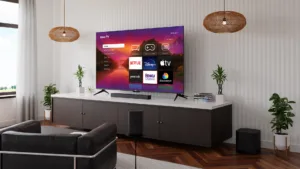The television industry has witnessed significant advancements in technology, leading to an enhanced viewing experience for consumers. With the introduction of smart TVs and 4K video, viewers have been exposed to novel features. However, the rapid evolution of TV technology, including the emergence of 8K sets, TV sets from service providers, and digital transitions for over-the-air broadcast TV, poses challenges for consumers to keep up with these innovations. That’s according to Hub Entertainment Research and its latest study on the Evolution of the TV Set.

The primary focus of this study was to investigate consumers’ awareness and adoption of various TV technologies. Key areas of interest include understanding consumers’ knowledge of TV technologies, their preferred devices and services, adaptation to emerging TV tech, and attitudes towards TVs and advertising. To gather insightful data, Hub conducted an online survey of 2,504 US consumers aged 16-74.
The results showed that almost all consumers have some knowledge of smart TVs, with half of them claiming to know a lot about these devices. 3 in 5 consumers have some awareness of 4K TV or UHD TV, while 3 in 10 have some understanding of 8K TVs. Although awareness of smart and 4K-capable TVs is on the rise, other emerging technologies struggle to gain traction.
The decision to watch 4K content is increasingly driven by value and available content rather than technical capabilities or access. Two-thirds of 4K-capable TV owners use their sets to watch 4K content, while only 1 in 6 non-4K viewers claim to be unsure of where to find such content. 3 in 10 non-4K viewers are content with regular HD.
Smart TVs have the potential to serve as a home hub for various content consumption. Half of smart TV owners now use their devices to stream music, an increase from just over a third two years ago. The use of smart TVs for casting and mirroring has more than doubled since 2021, providing an opportunity for original equipment manufacturers (OEMs) and TV app developers to capitalize on additional features beyond traditional TV viewing.
Roku remains a dominant player in the licensed TV OS space, with more smart TV homes using Roku OS sets compared to other licensed OS like Fire TV or Android TV. While overall familiarity with the Fire TV brand has increased, it still lags behind Roku. Additionally, Roku maintains a substantial lead in the streaming media players market.
Awareness of OEM FASTs is growing among smart TV streamers, with about 7 in 10 being aware of them in general. However, viewership of four major OEM FASTs has declined compared to the previous year, indicating a disconnect between increasing awareness and stagnant viewership. This presents a challenge for OEMs to better engage consumers with their FAST platforms.
The adoption of smart speakers connected to TVs has declined significantly from its peak in 2021. Currently, only 3 in 10 smart TV households have a smart speaker connected to their TV, with a third of them using it to control the TV. Overall smart speaker ownership has not increased since 2021. The decline in smart speaker usage for TV control may be attributed to the rise of voice-control TV remotes, smartphone apps, and a general decrease in enthusiasm for smart speakers.
A concerning finding relates to tracking viewers’ TV viewing habits. Over 2 in 5 smart TV users are unaware that their viewing may be tracked, and only 1 in 7 users are aware of or think they are opted-in for tracking. This discrepancy raises questions about transparency in the Terms of Service opt-in process and may lead to further privacy regulations, according to the report’s authors.

